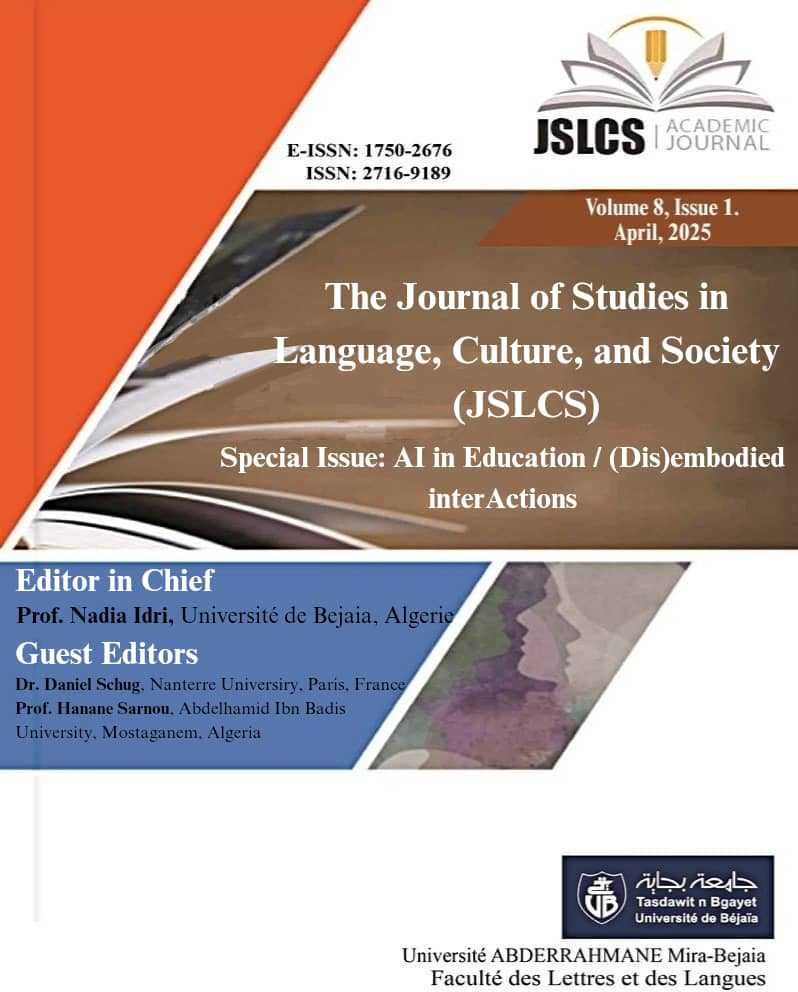Ai-powered Personalized Learning In Efl Acquisition: Exploring Adaptive Instruction And Feedback Systems
Keywords:
Adaptive Learning Systems, Artificial Intelligence (AI), EFL Acquisition, Language Learning Technologies, Personalized Learning, Real-Time FeedbackAbstract
The integration of Artificial Intelligence (AI) in English as a Foreign Language (EFL) instruction is revolutionizing traditional approaches by offering personalized learning experiences. This study investigates the potential of AI-powered adaptive learning systems to enhance EFL acquisition, focusing on how these technologies create individualized learning pathways and deliver real-time feedback. By examining AI-driven platforms that analyze student performance in areas such as grammar, pronunciation, and writing, this research evaluates their effectiveness in improving language fluency and retention compared to conventional teaching methods. Additionally, it addresses the pedagogical and ethical implications of AI in the classroom, including the balance between AI automation and the irreplaceable role of human educators. The study aims to provide a comprehensive understanding of how adaptive instruction, supported by AI, can transform EFL education and facilitate more tailored and efficient language acquisition.
References
Alafnan, Mohammad Awad. (2025, January). Artificial Intelligence and Language: Bridging Arabic and English with Technology. Journal of Ecohumanism, 4(1), 240–256. https://doi.org/10.62754/joe.v4i1.4961
Attali, Y., & Burstein, J. (2006). Automated Essay Scoring with e-rater®: Howe-rater®Works. Educational Testing Service.
Blaschke, L. M. (2012). Heutagogy and Lifelong Learning: A Review of Heutagogical Practice and Self-Determined Learning. The International Review of Research in Openand Distributed Learning, 13(1), 56-71.
Dörnyei, Z. (2005). The Psychology of the Language Learner: Individual Dif erences in Second Language Acquisition. Lawrence Erlbaum Associates. Godwin-Jones, R. (2018). Emerging Technologies: Language Learning in the Age of AI. Language Learning & Technology, 22(2), 3-8.
González-Lloret, M. (2016). The Role of Technology in Language Learning: Chatbots and Conversational Agents. In Technology-Enhanced Language Learning for English Language Learners (pp. 191-213). Springer.
Guan, L., Li, S., & Gu, M. M. (2024). AI in informal digital English learning: Ameta-analysis of its effectiveness on proficiency, motivation, and self-regulation. Computers and Education: Artificial Intelligence, 7, 100323. https://doi.org/10.1016/j.caeai.2024.100323130
Hattie, J., & Timperley, H. (2007). The Power of Feedback. Review of Educational Research, 77(1), 81-112.
He, T., & Zhu, C. (2022). The influence of artificial intelligence on language learning: A systematic literature review of empirical studies. Journal of Educational Computing Research, 60(1), 1-20.
Hooshyar, D., Weng, X., Sillat, P. J., Tammets, K., Wang, M., & Hämäläinen, R. (2024). The effectiveness of personalized technology-enhanced learning in higher education: Ameta-analysis with association rule mining. Computers & Education, 223, 105169. https://doi.org/10.1016/j.compedu.2024.105169
Hu, S. (2024, September). The effect of artificial intelligence-assisted personalized learningon student learning outcomes: A meta-analysis based on 31 empirical research papers. Science Insights Education Frontiers, 24(1), 3873–3894. https://doi.org/10.15354/sief.24.re395
Hwang, G.-J., & Chang, H. F. (2021). Personalized learning support in AI-enhanced education: Case studies and future trends. Computers & Education, 179, 104397. https://doi.org/10.1016/j.compedu.2021.104397.
Joshi, A., Dabre, R., Kanojia, D., Li, Z., Zhan, H., Haffari, G., & Dippold, D. (2025). Natural Language Processing for Dialects of a Language: A survey. ACM Computing Surveys. https://doi.org/10.1145/3712060
Karpicke, J. D., & Grimaldi, P. J. (2012). The Read-Recall Effect: A Method for Increasing Retention. Journal of Experimental Psychology: Learning, Memory, and Cognition, 38(5), 1268-1282.
Krashen, S. D. (1982). Principles and practice in second language acquisition. PergamonPress.
Littlewood, W. (2004). The Task-Based Approach: A Novel Method of Language Teaching. Language Teaching, 37(3), 215-229.
Liu, Q., & He, L. (2020). Using artificial intelligence to enhance personalized learning and feedback in English as a foreign language instruction. Journal of Artificial Intelligence in Education, 30(4), 367-388.
Liu, W., & Wang, Y. (2024, October). The effects of using AI tools on critical thinking in English literature classes among EFL learners: An intervention study. European Journal of Education, 59, e12804. https://doi.org/10.1111/ejed.12804
Luckin, R., Holmes, W., Griffiths, M., & Forcier, L. B. (2016). Intelligence Unleashed: An Argument for AI in Education. Pearson Education. Mebarkia, K., & Reffad, A. (2024). CNN models for Maghrebian accent recognition with SVM silence elimination. Signal, Image and Video Processing, 18(6–7), 1–10. https://doi.org/10.1007/s11760-024-03217-x
Miao, Y., Zhang, H., & Wang, X. (2021). Real-time feedback and adaptive learninginAI-powered English learning applications. International Journal of Artificial Intelligence in Education, 31(2), 255-270.
Mohebbi, A. (2024). Enabling learner independence and self-regulation in language education using AI tools: A systematic review. Cogent Education, 12(1). https://doi.org/10.1080/2331186X.2024.2433814
Nguyen, T. N. T., Lai, N. V., & Nguyen, Q. T. (2024, June). Artificial intelligence (AI) ineducation: A case study on ChatGPT’s influence on student learning behaviors. Educational Process International Journal, 13(2), 105–121. https://doi.org/10.22521/edupij.2024.132.7
Nguyen, T. T. T., & Hajek, J. (2022). Making the case for linguicism: Revisiting theoretical concepts and terminologies in linguistic discrimination research. International Journal of the Sociology of Language, 2022(275), 187–220. https://doi.org/10.1515/ijsl-2021-0028
Pérez-Paredes, P., & Alcaraz-Mármol, G. (2022). AI-powered language education: Real-time feedback, learner autonomy, and motivation. Language Teaching Research, 26(5), 770-784.
Richards, J. C., & Rodgers, T. S. (2014). Approaches and methods in language teaching(3rded.). Cambridge University Press.
Sebbah, L. (2025). Exploring Algerian EFL students’ familiarity, use, and attitudes toward generative artificial intelligence tools in education. Journal of Language and Translation, 5(1). https://doi.org/10.70204/jlt.v5i1.426
Shute, V. J. (2008). Focus on formative feedback. Review of Educational Research, 78(1), 153-189.
Wang, C., Li, Z., & Bonk, C. (2024, June). Understanding self-directed learning in AI-assisted writing: A mixed methods study of postsecondary learners. Computers and Education: Artificial Intelligence, 6(S1), 100247. https://doi.org/10.1016/j.caeai.2024.100247
Zwart, R. C., Wubbels, T., Bergen, T. C. M., & Bolhuis, S. (2009). Teacher learninginacollaborative context: Supervision, intervision, and peer coaching. TeachingandTeacher Education, 25(8), 997-1006.
Zwart, R. C., Wubbels, T., Bergen, T., & Bolhuis, S. (2009). Which Characteristics of a Reciprocal Peer Coaching Context Affect Teacher Learning as Perceived by Teachers and Their Students? Journal of Teacher Education, 60, 243-257. http://dx.doi.org/10.1177/0022487109336968
Vygotsky, L. S. (1978). Mind insociety:The development of higher psychological processes. Harvard University Press.








